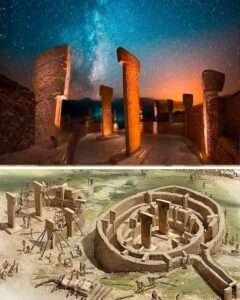The massive rock blocks depicted in the photo, each weighing several tons and towering up to nearly 7 meters in height, have been dated back to at least 11,000 years old through C14 radiocarbon analysis. These imposing structures are just a glimpse of the numerous pillars that once formed the ancient settlement of Göbekli Tepe, situated on the border between Turkey and Syria. Surprisingly, the civilization responsible for constructing this and similar sites remains nameless to this day, shrouded in obscurity until recent discoveries shed light on their existence.
Although enigmatic, some insights into their way of life have been gleaned. It is evident that the inhabitants of Göbekli Tepe did not engage in agriculture, as the seeds found within the site were of wild origin, not domesticated. Similarly, there is no evidence of animal husbandry, as the abundance of meat remnants discovered – indicating lavish feasts – predominantly belonged to game animals rather than livestock. Furthermore, the presence of stylized statues adorned in loincloths points to a relatively temperate climate during the construction of Göbekli Tepe, ruling out extreme cold conditions.

Contrary to popular assumptions, Göbekli Tepe does not appear to be a burial ground, given the absence of human remains within its confines. Nor does it seem to function as a place of worship, as no depictions of gods or deities have been uncovered. The absence of a sustainable water source also challenges the notion of it being a typical town or village capable of supporting a sizable population.
The intricately engraved depictions of serpents descending from above, adorning the walls of Göbekli Tepe, hint at a deeper narrative. Some astronomers suggest that around 12,000 years ago, Earth was subjected to a catastrophic event involving a barrage of asteroids or comets that ravaged landmasses across four continents, leaving widespread destruction in its wake. It is theorized that Göbekli Tepe may serve as a testament to this apocalyptic event, commemorating the reign of “fiery serpents” – fragments of comets or asteroids – that heralded a world-altering calamity.
As we ponder the significance of Göbekli Tepe and its enigmatic creators, we are left with a multitude of unanswered questions. Where are the cities inhabited by these ancient engineers? What were their societal customs and practices? Most intriguingly, what bequeathed them the knowledge and craftsmanship to erect such awe-inspiring structures? The mysteries surrounding Göbekli Tepe continue to intrigue and challenge our understanding of humanity’s distant past.





